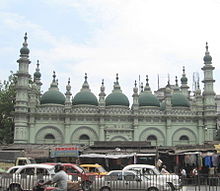Tipu Sultan Mosque
| Tipu Sultan Mosque | |
|---|---|
 |
|
| Basic information | |
| Location |
|
| Geographic coordinates | 22°33′55″N 88°21′06″E / 22.5653°N 88.3518°ECoordinates: 22°33′55″N 88°21′06″E / 22.5653°N 88.3518°E |
| Affiliation | Islam |
| District | Kolkata |
| Province | West Bengal |
| Country | India |
| Ecclesiastical or organizational status | Mosque |
| Architectural description | |
| Architect(s) | Prince Ghulam Mohammed |
| Architectural type | Mosque |
| Architectural style | Islamic, Mughal |
| Completed | 1842 |
| Specifications | |
| Direction of façade | South |
| Capacity | 1,000 |
| Dome(s) | 16 |
| Minaret(s) | 4 |
The Tipu Sultan Shahi Mosque (also known as Tipu Sultan Masjid) is a famous mosque in Kolkata, India. Located at 185 Dhartamtalla Street, the mosque is a relic of architectural and cultural heritage. People from all sections of society and religions are allowed to visit and take pictures of this historical premises.
This building was built in 1832 by Prince Ghulam Mohammed, the youngest son of Tipu Sultan. An identical mosque built later by the waqf committee is at Tollygunge. At first, Gholam Mohammed purchased a land in the central position of Calcutta and Built this beautiful mosque in 1842, in memory of his father Tipu Sultan. A news also was published, when he was purchased this land to build this big mosque. This mosque is a relic of architectural and cultural heritage of Kolkata. In early 80’s Tipu Sultan Masjid was damaged due to constructions works of Metro Railway in the Esplanade area. Nonetheless, after that, a committee was formed to repair the mosque. Afterward, the Mosque was restored with joint effort of Tipu Sultan Shahi Masjid Protection & Welfare Committee and Metro Railway.
“Tipu Sultan” (20 November 1750 – 4 May 1799) was the biggest character in Indian history. He was a ruler of Mysore and well known as a scholar and poet. Tipu Sultan Mosque was built here in Calcutta (now Kolkata) by his 11th son Prince Gholam Mohammed. They were the ruler of Mysore but why his youngest son built this mosque in memory of his father, far away from Mysore here in Calcutta. There is a history behind this.
Haider Ali was the father of Tipu Sultan and when the Vijaynagar Kingdom was dissolute, the kings of Yadava dynasty constituted the state of Mysore. During that time Haider Ali was Naib of the state and in 1755 he was appointed as Foujdar of Mysore. During misgovernance of the state, Haider Ali usurped his power and occupied Mysore. After his father Tipu Sultan became ruler and six years after of Tipu Sultan death, the entire family was transported to Calcutta by the British Government. During that period the capital of Mysore Srirangapatnam was captured by British Army. Son of Tipu Sultan, Gholam Mohammed when arrived in Calcutta, he was a kid then. He was a man of varied qualities. He was also involved in many public works and associated with a committee formed for maintenance of roadways and buildings.
The Tipu Sultan Shahi Masjid Protection & Welfare Committee was founded in the late 1980s by Seraj Mubarki, Mohammad Sharfuddin, Izhar Khan and Syed Zafar to educate people about the damage caused to the mosque by the Metro railway. This committee is headed by Mohammad Sharfuddin as its chairman.
...
Wikipedia
